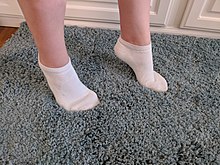
Back مشي على الأصابع Arabic Zehenspitzengang German راه رفتن روی انگشت پا FA Équinisme French הליכה על קצות האצבעות HE Toe walking Italian Echinism Romanian Tågång Swedish Parmak uçlarında yürüme Turkish
| Toe walking | |
|---|---|
 | |
| Toe walking | |
| Specialty | Pediatrics |
Toe walking is a term describing a type of walking style. Toe walking is when a person walks on their toes or the ball of their foot, without putting much or any weight on the heel or any other part of the foot.[1] Toe walking in toddlers is common. Children who toe walk as toddlers commonly adopt a heel-toe walking pattern as they grow older. If a child continues to walk on their toes past the age of three, or cannot get their heels to the ground at all, the medical authorities recommend they be examined by a health professional who is experienced in assessing children's walking.[2]
Toe walking can be associated with a number of health conditions, or have an unknown reason. When no medical reason for toe walking and no underlying condition can be identified, health professionals will commonly refer to it as "idiopathic" toe walking. This is not a formal or recognized diagnosis; rather, it is simply a term indicating that there is no identifiable reason or cause for the toe walking at that time. The child may have a diagnosis that becomes more apparent as they grow or never have a diagnosis that causes the toe walking.[3] Idiopathic toe walking should only be considered after all other conditions have been excluded. [4]
Other causes for toe walking include a congenital short Achilles tendon, muscle spasticity (commonly associated with cerebral palsy) or genetic diseases muscle disease such as Duchenne muscular dystrophy.[5] Toe walking may also be caused by a bone block located at the ankle which prevents the ankle from moving. This may be as the result of trauma or arthritis.[6] Toe walking may also be one way of accommodating a separate condition, foot drop. Persistent toe walking in children is also associated with developmental disabilities, such as autism.[7][8] In a recent study, 68% of children with an Autism Spectrum Disorder report experiencing walking changes.[9][10] Those with sensitive nervous systems, such as people with Autism Spectrum Disorder, Sensory Prosessing Disorder, or giftedness are also reported to be prone to toe walking.
It is estimated that 5% of healthy children have no reason for their toe walking (idiopathic toe walking).[11] Idiopathic toe walking has also been observed more in males than females when very large groups of children with toe walking are observed. One study looked for a family history of toe walking, and found a connection with family members all toe walking with no medical reason (idiopathic toe walking). This means there may be a genetic link with idiopathic toe walking.[12] Idiopathic toe walking spontaneously disappears over the years in the majority of cases and is most often not associated with a motor or cognitive issue.[13]
- ^ Kuijk, A; Kosters, R; Vugts, M; Geurts, A (2014). "Treatment for idiopathic toe walking: A systematic review of the literature". Journal of Rehabilitation Medicine. 46 (10): 945–957. doi:10.2340/16501977-1881. PMID 25223807.
- ^ "Toe Walking". Mayo Clinic. Archived from the original on 2007-06-03. Retrieved 2007-06-24.
- ^ Babb A, Carlson WO (2008). "Idiopathic toe-walking". South Dakota Medicine. 61 (2): 53, 55–7. PMID 18432151.
- ^ Williams, C; Tinley, P; Curtin, M (2010). "The Toe Walking Tool: a novel method for assessing idiopathic toe walking children". Gait & Posture. 32 (4): 508–11. doi:10.1016/j.gaitpost.2010.07.011. PMID 20692159.
- ^ Cite error: The named reference
emedicinewas invoked but never defined (see the help page). - ^ "Equinus Deformity at Foot Associates of Central Texas, LLC". 2009. Archived from the original on 2013-12-08. Retrieved 2013-12-11.
- ^ Sala DA, Shulman LH, Kennedy RF, Grant AD, Chu ML (1999). "Idiopathic toe-walking: a review" (PDF). Developmental Medicine & Child Neurology. 41 (12): 846–8. doi:10.1111/j.1469-8749.1999.tb00553.x. PMID 10619285.
- ^ Geschwind DH (2009). "Advances in autism". Annual Review of Medicine. 60 (1): 367–80. doi:10.1146/annurev.med.60.053107.121225. PMC 3645857. PMID 19630577.
- ^ Shetreat-Klein, Maya; Shinnar, Shlomo; Rapin, Isabelle (February 2014). "Abnormalities of joint mobility and gait in children with autism spectrum disorders". Brain and Development. 36 (2): 91–96. doi:10.1016/j.braindev.2012.02.005. PMID 22401670. S2CID 27287327.
- ^ Barkocy, Marybeth; Schilz, Jodi; Heimerl, Sandra; Chee, Madeleine; Valdez, Meghan; Redmond, Kelly (April 2021). "The Effectiveness of Serial Casting and Ankle Foot Orthoses in Treating Toe Walking in Children With Autism Spectrum Disorder". Pediatric Physical Therapy. 33 (2): 83–90. doi:10.1097/PEP.0000000000000784. PMID 33724238. S2CID 232242384.
- ^ Engstrom, P; Tedroff, K (2012). "The prevalence and course of idiopathic toe-walking in 5-year-old children". Pediatrics. 130 (2): 279–84. doi:10.1542/peds.2012-0225. PMID 22826572. S2CID 2915651.
- ^ Pomarino, David; Ramírez Llamas, Juliana; Pomarino, Andrea (2016). "Idiopathic Toe Walking Family Predisposition and Gender Distribution". Foot & Ankle Specialist. 9 (5): 417–422. doi:10.1177/1938640016656780. PMID 27370652. S2CID 1160638.
- ^ "Votre enfant marche sur la pointe des pieds? Pas de quoi s'inquiéter". naitreetgrandir.com (in French). Retrieved 2023-07-20.